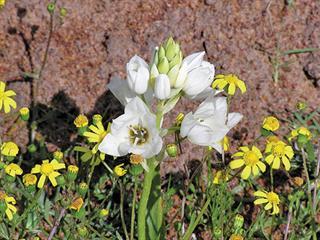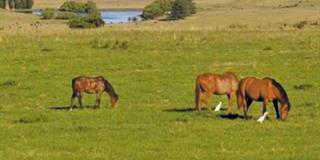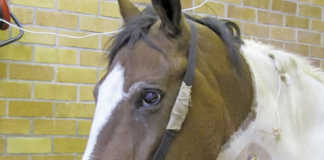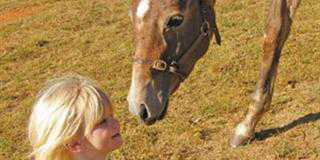
Chinkerinchees were first described in the Cape as early as 1776. The common name derives from the ‘chinking’ sound made when the leaves are rubbed together. Although the flower is indigenous to the Western and Northern Cape, horses are often poisoned in other areas of South Africa, where chinkerinchees are grown as a decorative garden plant and accidentally colonise pastures.
They are equally toxic when dried and particularly dangerous when baled with hay, as horses will usually avoid the fresh plant when grazing. The scientific name is Ornithogalum thyrsoides and it’s also known as the ‘Star of Bethlehem’, as the white flowers are star-shaped, with a brown or black centre that becomes paler with age.
The plant occurs naturally between Caledon and Namaqualand, in disturbed ground, marshy hollows and on damp mountain slopes. It is a perennial herb between 20cm and 50cm high with a round bulb that becomes dormant in the winter. It multiplies and spreads by both seeds and bulbs, and growth and spread appear to be promoted after fires.
The flowers appear as
a tight group at the top of a short, thick, fleshy stem. Leaves are spear-shaped, bright green and fleshy, and grow out of the bulb in September or early October. They die back when the flower develops. Chinkerinchee flowers are very long-lasting and plants flower until February. This is what makes them popular as garden plants or cut flowers.
Toxicity
The leaves are an irritant to the skin and this may be why horses learn to avoid them, as the level of deaths is low in horses brought up in endemic areas, although newly introduced horses may be poisoned. The toxicity is caused by cholestaneglycocides. These chemicals affect the heart muscle and nervous system. They are also gastrointestinal irritants.
Within a few hours of ingesting the leaves or flowers, horses stop eating and appear drowsy, and may stagger when forced to walk. The most typical symptom, though, is a profuse watery diarrhoea. Death usually ensues within 24 hours.
Prof Christo Botha, a veterinary specialist toxicologist, reports that a horse can die after eating as few as eight flowers.
Treatment is symptomatic, which means that horses are put on an intravenous drip and kept in a stable with deep bedding.
There is no antidote and treatment is not always successful.
Essential to remove bulbs
Horse owners should never use chinkerinchees as an ornamental plant. Even when the plants and flowers are dug up and thrown out of gardens, they can poison horses. In endemic areas, the only effective method of control is to dig up the bulbs.
Chemical control using weedkillers was attempted in Australia, but was not entirely successful. Deep ploughing and raking is required before planting pastures. Before cutting hay, lands should be carefully inspected and individual plants removed.













